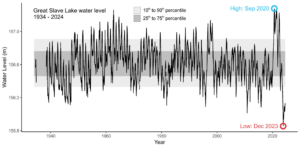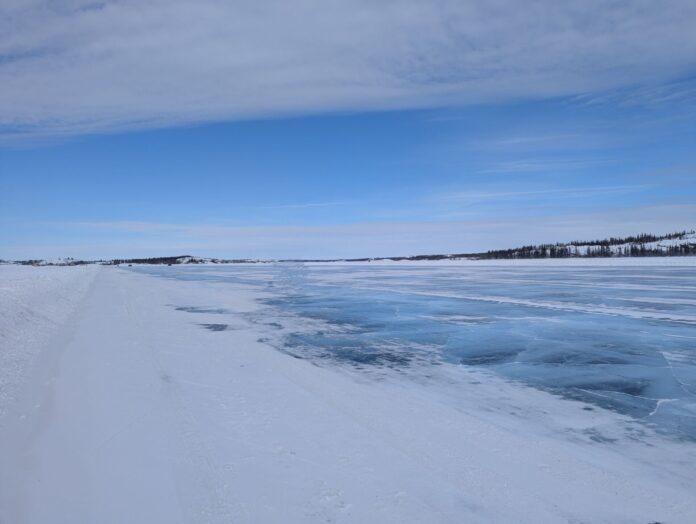Earth Day is calling attention to the “transformative power” of natural wonders like the Great Slave Basin and the global need to protect them.
April 22 marks the 55th anniversary of Earth Day. People across the territories are taking time to reflect and to take action in response to environmental issues. Over one billion people in 192 countries across the world are expected to participate in Earth Day celebrations.
This year’s Earth Day celebrations focus on protecting and channelling renewable, green energy, with a goal to triple renewable energy generation by 2030.
NWtT’s 2030 strategy is a long-term approach towards green, renewable, affordable and sustainable energy supply by 2030.
A recent federal climate report warned that the territories are warming “about four times the global rate.”
The increase in temperature is having major impacts on the environment. Impacts include increasing permafrost thaw, greater coastal and river erosion, changing ice conditions and longer ice-free seasons, changes to water quality and quantity and increasing risk of wildfires.
Climate change is the “long-term shifts in temperatures and weather patterns” (United Nations 2025).
The main causes of climate change are fossil fuels such as coal, oil and gas. They are the source of over 75 per cent of the world’s greenhouse gas emissions and almost 90 per cent of carbon dioxide emissions.
Greenhouse gas emissions trap the sun’s heat around the Earth, leading to global warming and climate change. According to United Nations researchers, the planet is warming faster than at any other time in recorded history.
“These changes to the natural environment are also impacting the health and well-being of the territory’s residents and their traditional livelihoods, as well as our infrastructure and economy,” said the GNWT in a recent report.
In the territories, the stewardship of the land is a critical value rooted in Indigenous traditions and cultures since time immemorial. In N.W.T., Indigenous and non-Indigenous people continue that deeply rooted tradition.
Communities and organizations across the North are searching for ways to protect the environment and mitigate the impacts of climate change.
Monitoring the health of the air, oceans, soil, ecosystems, wildlife, and human health is a daily mission for scientists like Emma Riley, who is a hydrologist at GNWT’s Water Monitoring and Stewardship Division.
Riley spoke with True North FM recently about the important role of water systems, also known as hydrology, across the Great Slave Basin and the Mackenzie River Basin.
The Great Slave Lake is connected to many surrounding waterways that extend far into provinces and territories.
“I think when we think about Great Slave Lake, the first thing that I really want people to understand is that the area that contributes to the lake is much greater than one might expect. So, the great Slave Lake Basin contains all the area that if precipitation falls, it’s directed to the lake.”
The Basin extends into large areas of BC, Alta. and Sask. The Slave River Basin comes up across Alta’s border.
“That Basin delivers about 80 per cent of the water to Great Slave Lake. So really when we think about what’s going on there and what’s changing over time, it’s that Basin that’s dictating a lot of the change that we’re seeing,” explained Riley.
Water levels on the Great Slave Lake hit record lows in September 2020. Riley explained that water level measurements are compared to records going back about 100 years.

2021 was also an “unprecedented” year for water levels in N.W.T. including the Great Slave Lake. The water levels continued to rise higher than average. Shane Thompson, the then-Minister of Environment and Natural Resources, issued a statement reassuring communities across NWT that the situation was being monitored and investigated.
Record water level lows continued in 2023
“And again, in 2024 exceeding those record lows,” remembered Riley.
“Water levels are still below average across the majority of the territory,” said Riley.
Riley says the low levels have to do with climate change.
“2023 was the hottest year on record globally and that drove a lot of drought conditions. So we saw these drought conditions in 2023 in summer and in 2024 in the summer with really above normal temperatures and really low precipitation.”
Riley explained that water levels are connected to the risk of forest fires. In 2023 wildfires devastated many regions across the country, including N.W.T.
Climate change is driving the lowering water levels in the Great Slave Basin.
“So you’re going to have the intensification of the hydrological cycle, which means increases in evaporation, increases in precipitation, increases in runoff, that whole entire cycle is going to intensify with time.”
And climate change also drives variability in precipitation patterns, making patterns hard to predict, said Riley.
“Those two (factors) coupled mean that climate change drives higher likelihood of floods and droughts,” explained Riley.
Water levels affect the entire ecosystem, including the health of fish populations and water quality. Water levels have major cultural and economic impacts.
Riley explained that the barge that goes down the Mackenzie River was cancelled last year.
“That’s been a major implication for low water levels in the territory because the goods to certain communities were halted last year because of the cancellation.”
Water levels are important for many reasons and one of those reasons has to do with the ability to generate hydroelectric power. Rivers and lakes across the territories provide an important source and potential source of green, sustainable hydroelectric power.
The Talston River, the Snare River are both part of the Mackenzie River Basin which provides the region with green, sustainable energy.
The Talston Hydro System provides green, sustainable power to communities in the South Slave region. The Snare Hydro System provides power to Yellowknife, Behchoko and Dettah, north of Great Slave Lake.
NWT’s water systems provide a critical source of green, sustainable energy for communities, but climate change also impacts them.
Riley explained that precipitation over the last two summers has been pretty low across the territories. Moisture has also been low across the territories.
Since December there has been some increase in precipitation that has brought a “little bit of recovery,” explained Riley.
While water levels remain way below average, there are small signs of change.
“Compared to last year, we have seen a little bit of recovery, but (water levels) are still well below average on the lake and they’re below average on a couple of points on the Mackenzie River as well,” said Riley.
“On Great Slave Lake, we’re actually sitting at about 30 centimetres higher than the water level measured last year,” explained Riley.
A main reason for the improvements has to do with the Slave River.
“The Slave River water levels have been approximately average since December of 2024, so we’ve got a lot more water from that particular river being delivered to the lake this year compared to last year. So we have seen some small improvements on the lake itself and obviously the river compared to this time last year which is a little bit of recovery there.”
The snowpack distribution across the McKenzie River Basin and the Slave River Basin is higher than the snowpack last year, said Riley.
The small changes seen on Great Slave Lake are because Slave River inflows have been “approximately average so far this winter,” said Riley.
“So any recovery that we see is going to be driven by precipitation mostly which is driven by local weather patterns, but also global weather patterns as well and climate change.”






